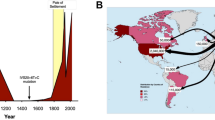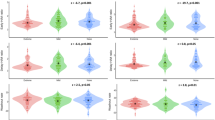Abstract
This study tested whether familial dysautonomia (FD) involves progressive loss of noradrenergic nerves. Plasma levels of catechols, including dihydroxyphenylglycol (DHPG), norepinephrine (NE), dopamine (DA), and DOPA, were measured in 7 adult patients with FD and 50 healthy control subjects. FD patients were re-tested after a mean follow-up period of 13 years. Compared to controls, FD patients had low plasma levels of DHPG (P < 0.001), high DOPA and DA levels (P = 0.01, P = 0.0002), and high NE:DHPG (P < 0.0001), DA:NE (P = 0.0003), and DOPA:DHPG (P < 0.0001) ratios. At follow-up there were no changes in plasma levels of individual catechols; however, there were further increases in DOPA:DHPG ratios (mean 24 ± 7%, P = 0.01). In FD, plasma catechol profiles are sufficiently stable, at least over a decade, to be used as a biomarker of disease involvement. An increasing DOPA:DHPG ratio suggests slight but consistent, progressive loss of noradrenergic neurons.


Similar content being viewed by others
Abbreviations
- DHPG:
-
Dihydroxyphenylglycol
- EPI:
-
Epinephrine (adrenaline)
- NE:
-
Norepinephrine (noradrenaline)
- DA:
-
Dopamine
- DOPA:
-
3,4–dhihydroxyphenylalanine
- DOPAC:
-
Dihydroxyphenylacetic acid
- FD:
-
Familial dysautonomia
References
Slaugenhaupt SA, Blumenfeld A, Gill SP et al (2001) Tissue-specific expression of a splicing mutation in the IKBKAP gene causes familial dysautonomia. Am J Hum Genet 68:598–605
Close P, Hawkes N, Cornez I et al (2006) Transcription impairment and cell migration defects in elongator-depleted cells: implication for familial dysautonomia. Mol Cell 22:521–531
Pearson J, Pytel BA (1978) Quantitative studies of sympathetic ganglia and spinal cord intermedio-lateral gray columns in familial dysautonomia. J Neurol Sci 39:47–59
Hilz MJ, Axelrod FB, Bickel A et al (2004) Assessing function and pathology in familial dysautonomia: assessment of temperature perception, sweating and cutaneous innervation. Brain 127:2090–2098
Pearson J, Gallo G, Gluck M et al (1980) Renal disease in familial dysautonomia. Kidney Int 17:102–112
Ziegler MG, Lake CR, Kopin IJ (1976) Deficient sympathetic nervous response in familial dysautonomia. N Engl J Med 294:630–633
Smith AA, Taylor T, Wortis B (1963) Abnormal catechol amine metabolism in familial dysautonomia. N Engl J Med 268:705–707
Goodall MC, Gitlow SE, Alton H (1971) Decreased noradrenaline (norepinephrine) synthesis in familial dysautonomia. J Clin Invest 50:2734–2740
Weinshilboum RM, Axelrod J (1971) Reduced plasma dopamine-beta-hydroxylase activity in familial dysautonomia. N Engl J Med 285:938–942
Freedman LS, Ebstein RP, Goldstein M et al (1975) Serum dopamine-beta-hydroxylase in familial dysautonomia. J Lab Clin Med 85:1008–1012
Axelrod FB, Goldstein DS, Holmes C et al (1996) Pattern of plasma levels of catecholamines in familial dysautonomia. Clin Auton Res 6:205–209
Goldstein DS, Eisenhofer G, Stull R et al (1988) Plasma dihydroxyphenylglycol and the intraneuronal disposition of norepinephrine in humans. J Clin Invest 81:213–220
Pearson J, Brandeis L, Goldstein M (1979) Tyrosine hydroxylase immunoreactivity in familial dysautonomia. Science 206:71–72
Axelrod FB, Iyer K, Fish I et al (1981) Progressive sensory loss in familial dysautonomia. Pediatrics 65:517–522
Holmes C, Eisenhofer G, Goldstein DS (1994) Improved assay for plasma dihydroxyphenylacetic acid and other catechols using high-performance liquid chromatography with electrochemical detection. J Chromatog B Biomed Appl 653:131–138
Goldstein DS, Eisenhofer G, Kopin IJ (2003) Sources and significance of plasma levels of catechols and their metabolites in humans. J Pharmacol Exp Ther 305:800–811
Goldstein DS, Udelsman R, Eisenhofer G et al (1987) Neuronal source of plasma dihydroxyphenylalanine. J Clin Endocrinol Metab 64:856–861
Eisenhofer G, Brush JE, Cannon RO III et al (1989) Plasma dihydroxyphenylalanine and total body and regional noradrenergic activity in humans. J Clin Endocrinol Metab 68:247–255
Micalizzi ER, Pals DT (1979) Evaluation of plasma norepinephrine as an index of sympathetic neuron function in the conscious, unrestrained rat. Life Sci 24:2071–2076
Slaugenhaupt SA, Mull J, Leyne M et al (2004) Rescue of a human mRNA splicing defect by the plant cytokinin kinetin. Hum Mol Genet 13:429–436
Acknowledgment
This research was supported by the Intramural Research Program of the NIH, National Institute of Neurological Disorders and Stroke.
Author information
Authors and Affiliations
Corresponding author
Rights and permissions
About this article
Cite this article
Goldstein, D.S., Holmes, C. & Axelrod, F.B. Plasma Catechols in Familial Dysautonomia: A Long-term Follow-up Study. Neurochem Res 33, 1889–1893 (2008). https://doi.org/10.1007/s11064-008-9662-4
Received:
Accepted:
Published:
Issue Date:
DOI: https://doi.org/10.1007/s11064-008-9662-4




